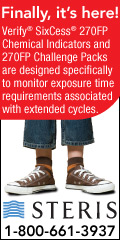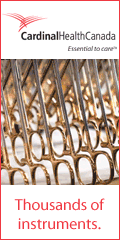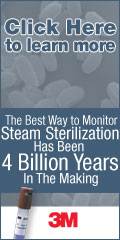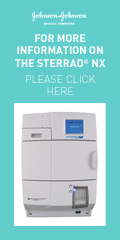
| Past Issues | Advertise | www.csao.net | January 7, 2011 |
Safety and Sharps in CSD
Reprocessing of reusable surgical instruments is one of the primary activities that occur each day in Central Services. The process involves decontamination, inspection and assembly, sterilization, sterile storage and distribution of instruments before next patient use. Decontamination is the first part of the process, where contaminated instruments are received. Hazards that staff face in this area are biological, chemical and physical in nature. Contaminated sharps are one of these hazards that pose both risk management and infection control concerns.
Contaminated sharps may be defined as any object that can penetrate the skin, including but not limited to needles, scalpels and broken glass. Hazardous contaminated sharps that are of concern in Central Services can be grouped into two classes, Disposable sharps and Reusable sharps. Disposable sharps, items such as single use needles, blades and suture needles, should be disposed of at point of use. Reusable sharps are items like scissors, skin hooks or towel clamps that are designed to be reprocessed between uses and should be sent to Central Services after use. The main safety concern is the potential exposure from a puncture wound from these contaminated sharps and transmission of pathogenic microbes through the skin. Why is this of concern if sharps are part of our daily work? Many of the operating room instrument sets can have as many as 75-100 items and reusable sharps may be difficult to see and handle when the sets are being decontaminated. As well, single use sharps are sometimes sent to CS in an instrument tray (i.e. blade left on knife handle) instead of disposal in a sharps container at point of use.
What can be done to help keep staff in Central Services in a safe working environment? Four strategies can be employed. Firstly, a safety task force can function to bring safety concerns forward. A Safety or Quality and Risk group that meets regularly and has a diverse membership (physician, nursing, materials, CS, biomedical, infection control and risk) is an effective way to bring any safety concern forward. By bringing any issues to this forum, policies, procedures and work practices may be developed to help control risk. Secondly, a training plan should include all staff that are part of the process of dealing with contaminated sharps. New employees should be made aware of the policies and procedures in place, PPE made available, proper disposal and handling procedures reviewed and how incident reports are initiated. Thirdly, awareness campaigns are valuable to help educate the end users of sharps and CS staff on information regarding disease transmission risks and sharps. They may include Safety Rounds, newsletters, posters or staff meetings. Finally, tracking of at risk cases and surgeries to identify where contaminated disposable sharps arise from (ER, OR, Radiology, etc...) is an important part of completing an Incident or Safety Report. This allows effective follow up with departments and staff involved. Injured staff may require medical attention and follow up. Incident reporting systems provide valuable information in tracking and resolving the Safety Reporting trends.
What can the users of reusable and disposable sharps do?
What can Central Services staff do? |
Box 225 / Timmins, ON / P4N 7CP
Phone: 705.268.4763
Fax: 705.268.4421







